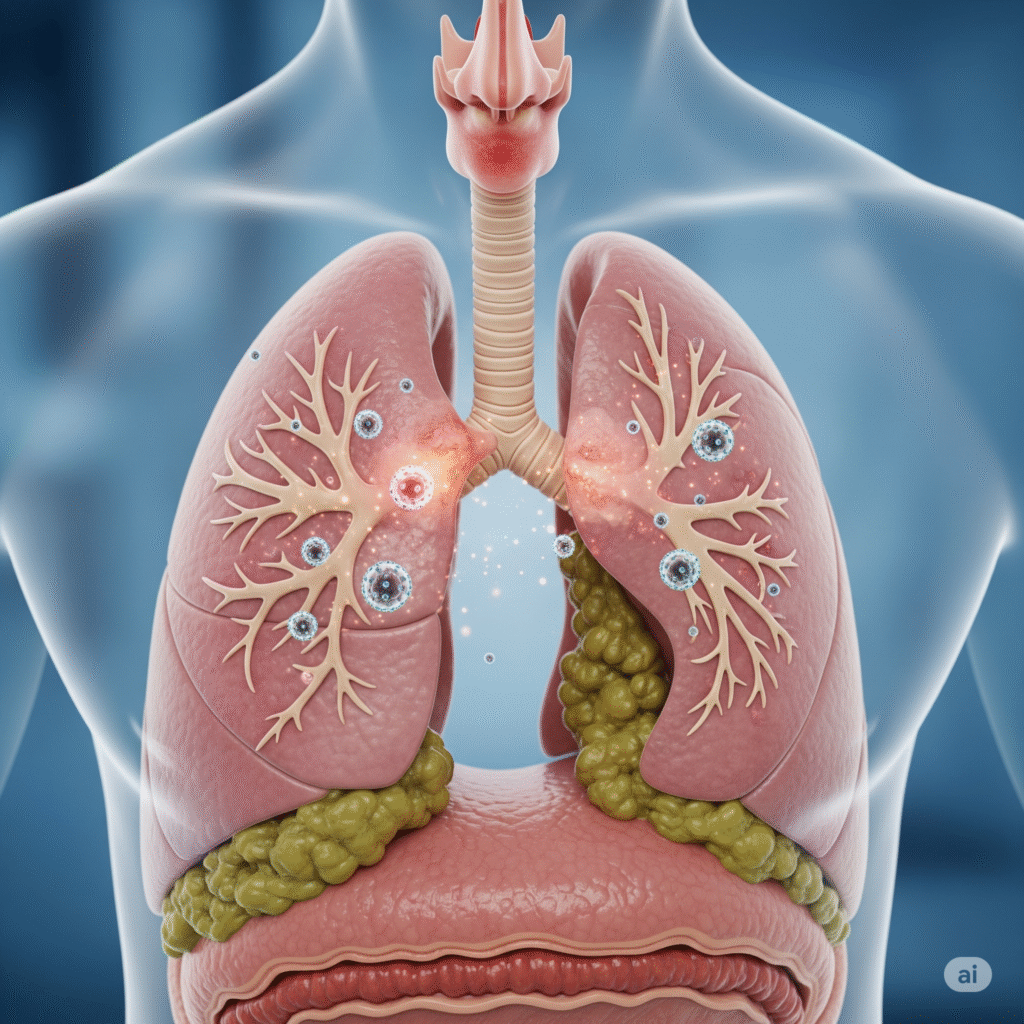respiratory tract infection
Introduction
Respiratory tract infections (RTI) are diseases that affect parts of the respiratory system, including nose, throat, airways and lungs. They can be caused by viruses, bacteria, or fungi and are usually classified into upper respiratory tract infections (URTIS) and low respiratory tract infections (LRTI). Symptoms vary depending on the site and severity, from mild cold and sore throat to severe pneumonia or bronchitis. RTIs spread through droplets mainly with persons infected with cough, sneezing or close contact.

Types of respiratory tract infection
Normal cold
A mild viral infection of the upper respiratory tract due to rhinovirus, coronvirus, or adenovirus. Symptoms include flowing nose, sneezing, sore throat and mild fever.
Influenza (flu)
Due to the influenza virus, it affects both the upper and lower respiratory tract. Symptoms are high fever, body pain, headache, fatigue and dry cough.
Clinical features
Inflammation of the bronchi, usually caused by viral or bacterial infection. It causes persistent cough, mucus production, discomfort of the chest and sometimes wheezing.
Pneumonia
Lung infection due to bacteria, viruses or fungi. Symptoms include high fever, chills, productive cough, chest pain and difficulty in breathing.
Causes of respiratory tract infection
- Viral infections such as rhinovirus, coronvirus, influenza and RSV are common causes.
- Bacterial pathogens such as Streptococcus pneumonia, hemophilus influenza, and mycoplasma pneumonia can infect the airways.
- Fungi organisms such as aspergillus and histoplasma can lead to infection in immunological individuals.
- The poor air quality from pollution, dust or smoke reduces respiratory prevention.
- Smoking causes damage to airways lining and cilia, which reduces pathogens to clean.
- Weak immune system increases risk from HIV, diabetes, cancer or some drugs.
- Close contact with infected individuals allow small drop transmission.
- The cold weather promotes indoor congestion and mucosal reduces immunity.
- Eating allergies such as grass fever, increases sensitivity to infection.
- Professional risk in mines, construction, or animal handling increases respiratory infection risk.
- Chronic respiratory diseases such as asthma, COPD, or cystic fibrosis are more likely to infection.
Clinical features of respiratory tract infection:
cough
The mucus can be dry or productive, it depends on whether the infection is viral, allergic in bacterial or nature.
Fever
Often present in infections, indicating the body’s immune response to the attacker pathogens.
sore throat
Inflammation of the throat and pharynx causes pain or discomfort, especially while swallowing.
Nose
Common in infection of the upper respiratory tract due to inflammation and excess mucus production.
Breathing difficulty
Oxygen was seen in infection of low respiratory tract when the lungs are affected, to reduce oxygen exchange.
Symptoms associated with respiratory tract infection
- Cough, either dry or mucus, is usually experienced.
- Fever occurs when the body fights infectious disease agents.
- Sore throat causes pain, especially noticeable while swallowing food.
- Nasal congestion or flowing nose resulted in an increase in mucus production.
- Sneezing is caused by irritation or swelling in the passage of the nose.
- The active response to the immune system is accompanied by fatigue and body pain.
- Breathing discomfort occurs in severe low respiratory tract infections.
- Headache is the result of fever, sinus pressure, or inflammation of the nasal passage.
Investigations in respiratory tract infection
- Pneumonia, tuberculosis, mass, or fluid produces wide images of the lungs and chest to detect accumulation, helps in detecting and assessing the range of infection.
Bacteria, viral, or fungal pathogens analyze mucus from the lungs, and can detect tuberculosis or unusual cells for diagnosis and targeted treatment.
To assess the presence, type and severity of infection, white blood cell count and markers such as C-reactive proteins, help in guide treatment decisions.
Provides high-resolution lung images, which reveal invisible infections, boils, or tumors on X-rays, assisting in subtle or unclear cases.
Non-invasive method useful in measuring blood oxygen saturation, detection of hypoxia, and in order to monitor respiratory efficiency in severe infections.
A flexible tube with a camera is inserted into the airways to imagine direct transition in the airways, collect samples and control the obstruction.
Helps the sample from the throat to identify pathogens such as Streptococcus, confirm the diagnosis and select suitable antibiotics.
Measures acid reflux in the throat and airways, it is useful in detection of cough or infection for gastroosophageal reflux disease.
